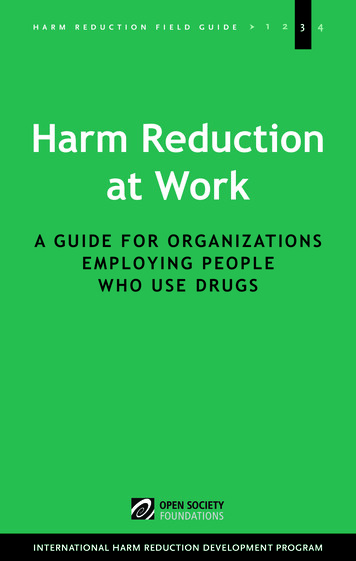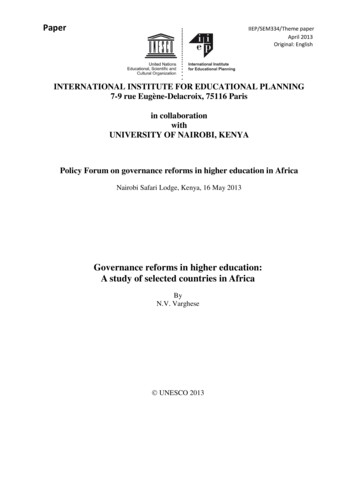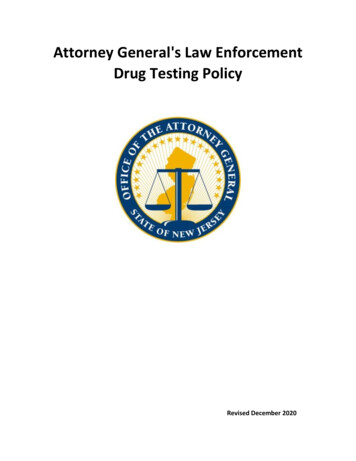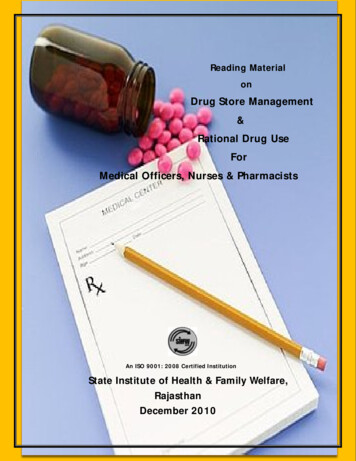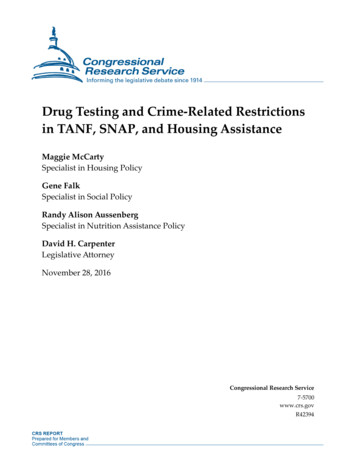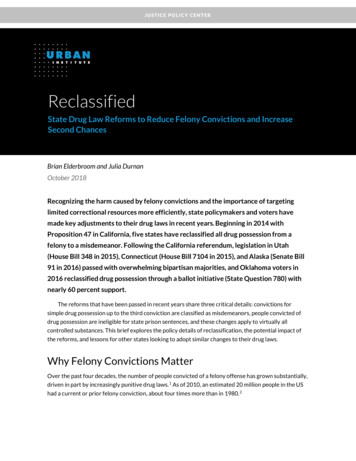
Transcription
JUSTICE POLICY CENTERReclassifiedState Drug Law Reforms to Reduce Felony Convictions and IncreaseSecond ChancesBrian Elderbroom and Julia DurnanOctober 2018Recognizing the harm caused by felony convictions and the importance of targetinglimited correctional resources more efficiently, state policymakers and voters havemade key adjustments to their drug laws in recent years. Beginning in 2014 withProposition 47 in California, five states have reclassified all drug possession from afelony to a misdemeanor. Following the California referendum, legislation in Utah(House Bill 348 in 2015), Connecticut (House Bill 7104 in 2015), and Alaska (Senate Bill91 in 2016) passed with overwhelming bipartisan majorities, and Oklahoma voters in2016 reclassified drug possession through a ballot initiative (State Question 780) withnearly 60 percent support.The reforms that have been passed in recent years share three critical details: convictions forsimple drug possession up to the third conviction are classified as misdemeanors, people convicted ofdrug possession are ineligible for state prison sentences, and these changes apply to virtually allcontrolled substances. This brief explores the policy details of reclassification, the potential impact ofthe reforms, and lessons for other states looking to adopt similar changes to their drug laws.Why Felony Convictions MatterOver the past four decades, the number of people convicted of a felony offense has grown substantially,driven in part by increasingly punitive drug laws. 1 As of 2010, an estimated 20 million people in the UShad a current or prior felony conviction, about four times more than in 1980. 2
Felony convictions for drug law violations are also a major driver of prison admissions in manystates. 3 While prison admissions for drug offenses have declined in recent years, more people were sentto prison for drug offenses than violent crimes every year from 1993 to 2009. 4 In 2016, almost 280,000people were incarcerated for drug offenses in state and federal prisons (nearly 1 in 5). 5This growth has occurred at great public expense, despite the fact that research shows public healthresponses to drug use are more effective than criminal justice responses and incarcerating people fordrug offenses has a questionable impact on public safety. 6 In fact, a recent analysis of state correctionsand public health data found no relationship between imprisonment rates and rates of drug use,overdose deaths, or arrests for drug law violations. 7 In other words, evidence shows more punitivecriminal justice responses such as felony convictions are not effective tools to deter drug use or mitigatethe harm it can cause.On the other hand, for people convicted of felony offenses and the communities in which they live,there are numerous negative impacts. 8 Felony convictions can lead to jail or prison time and canincrease prison sentences by years or even decades due to sentencing enhancements. 9 Periods ofincarceration, even relatively short ones, can affect a person’s ability to secure and maintainemployment and housing, as well as fulfill family obligations such as parenting and child support. 10We can't just warehouse people. There needs to be rehabilitation, especially for nonviolentoffenders. There ought to be a better way to do this so we don't have a revolving door.—Utah Governor Gary Herbert, Salt Lake Tribune, November 12, 2014People with a felony record are also subject to numerous extrajudicial punishments and restrictions(known as collateral consequences), which go beyond the direct impact of incarceration and number inthe hundreds in many states. 11 Among the most common collateral consequences placed on people withfelony convictions are bans on employment in professions as far-ranging as real estate, banking,cosmetology, and pest control. 12 Research demonstrates that such limitations can undermine publicsafety, as access to jobs is a key factor in reducing risk to recidivism. 13 Still, many employers requireapplicants to disclose whether they have been convicted of a felony crime, despite efforts to “ban thebox” on job applications in many state and local governments. 14As a result, felony convictions impact job security for those who are sentenced to probation and area major barrier to success for those returning home from prison. But there are also broader societalcosts. Limiting opportunities for people to find and keep a job contributes to high unemployment rates,low productivity, and financial insecurity. According to one study, felony convictions in the US lead to aloss of as much as 87 billion in annual GDP. 15Another serious consequence of rising felony convictions is the widespread loss of voting rights. Anestimated 6.1 million Americans—2.5 percent of the total voting-age population—are denied the right to2RECLASSIFIED: STATE DRUG LAW REFORMS TO REDUCE FELONY CONVICTIONS
vote through felony disenfranchisement laws. 16 Several states impose restrictions on voting even afterpeople have completed their sentences, resulting in disenfranchisement rates of 7 percent or higher inKentucky, Mississippi, Tennessee, Florida, and Virginia. 17 Evidence suggests that permanent felonydisenfranchisement laws are costly and could have a negative impact on rearrest rates for peoplereleased from prison. 18Florida has the most restrictive law in the country and blocks 1.5 million residents—10 percent ofthe voting-age population—from exercising their right to vote. 19 Nearly 90 percent of thedisenfranchised people in Florida have completed their sentences and cannot vote because of old felonyconvictions. 20 Recent analysis estimated the economic statewide impact of restoring voting rights forpeople convicted of a felony in Florida at 365 million annually. 21Felony convictions impose a particularly heavy burden on communities of color. Despite usingillegal drugs at similar rates to white people, 22 black people are arrested for drug offenses nearly threeto four times more often. 23 This contributes to significant racial disparities throughout the criminaljustice system. In 2010, 25 percent of black people had a current or prior felony conviction (comparedwith just 6 percent of the rest of the population), and researchers estimate that one in three black menwill be convicted of felony offenses in their lifetimes. 24Reclassifying Drug Possession to a MisdemeanorOver the past two decades, states have implemented numerous reforms to more effectively hold peopleaccountable for drug offenses and address underlying substance use disorders when appropriate. Theseinclude creating and/or expanding drug courts, providing treatment as an alternative to incarceration,and, most recently, redefining and reclassifying drug offenses in criminal statute. This shift reflects agrowing recognition that prevention and treatment programming provided outside the criminal justicesystem can be more effective than relying solely on punishment to stop illegal substance use. 25RECLASSIFIED: STATE DRUG LAW REFORMS TO REDUCE FELONY CONVICTIONS3
Though people come into contact with the justice system for a range of drug-related offenses,possession makes up a significant proportion of cases. In fact, more than 80 percent of arrests for druglaw violations are for drug possession alone, 26 and 3.4 percent of the state prison population—nearly50,000 people—is incarcerated for drug possession. 27 There are no available estimates of how manypeople have a felony conviction for drug possession, or the impact of old felony convictions for drugpossession on prison sentences and time served, but treating drug possession as a misdemeanor offensecould reduce criminal justice spending and eliminate the harmful impact of a felony conviction. 28BOX 1MethodologyTo identify states that classify drug possession as a misdemeanor, the Urban Institute conducted a 50state scan of criminal laws related to drug possession, tracking and recording the following in each state: drug possession classifications in state law for each controlled substance (felony ormisdemeanor); definitions such as weight thresholds for felony drug possession; possession with intent to distribute (PWID) statutes, including any legal presumptions orguidance related to charging and prosecuting PWID; and criminal history exclusions or habitual offender sentencing enhancements that affect theclassification of drug possession convictions.Through this scan, we identified five states as of 2018 that classify simple drug possession forvirtually all drugs and weights as a misdemeanor (up to at least the third conviction) and make drugpossession offenses ineligible for prison time.As of 2018, five states have reclassified simple drug possession as a misdemeanor. The first statewas California with the passage of its 2014 voter-approved Proposition 47. 29 This ballot initiativereclassified several nonviolent offenses (including drug possession) from felonies to misdemeanors,authorized the removal of felony records for people with old felony convictions, and required the stateto annually reinvest the savings from reduced prison spending into crime prevention programs, drugand mental health treatment, and trauma recovery services for victims of crime.After the passage of Proposition 47 in November 2014, Utah, 30 Connecticut, 31 Alaska, 32 andOklahoma 33 also reclassified drug possession from a felony to misdemeanor. While there are keydifferences in who is eligible and how drug possession is defined, the reforms in these five states sharethree important policy details:1.2.Convictions for drug possession are misdemeanors (up to at least the third conviction).Someone convicted of drug possession is ineligible to serve time in prison (up to at least thethird conviction).4RECLASSIFIED: STATE DRUG LAW REFORMS TO REDUCE FELONY CONVICTIONS
3.Weight limits are not specified, and drug possession is a misdemeanor crime for virtually allcontrolled substances.As shown in table 1, three of the five states have criminal history exclusions that make peopleeligible for a felony sentence or prison time if they have prior felony convictions. In Utah andConnecticut, convictions for drug possession become a felony after two prior drug possessionconvictions. In California, people with prior convictions for serious or violent offenses are not eligiblefor a misdemeanor sentence.TABLE 1State Reforms to Reclassify Drug UtahMisdemeanorsentenceIneligible forprisonWeight anddrug type notspecifiedNo criminalhistoryexclusions Retroactive Sources: Alaska Senate Bill 91 (2016); California Proposition 47 (2014); Connecticut House Bill 7104 (2015); Oklahoma StateQuestion 780 (2016); and Utah House Bill 348 (2015).Notably, California is the only state to allow these changes to be applied retroactively; meaningpeople who have been convicted of one of the offenses changed by Proposition 47 can apply forresentencing or reclassification. As of March 2018, more than 340,000 petitions for resentencing andrecord change have been filed in California courts, 34 and it has been estimated that as many as 1.5million Californians may be eligible to apply. 35In many states, people convicted of possessing drugs under certain weight thresholds receive amisdemeanor sentence. 36 A few states classify all simple drug possession as a misdemeanor but eitherhave extremely low weight thresholds, resulting in possession of even small amounts of a drug beingclassified as PWID (Tennessee), 37 or allow prison sentences for misdemeanor convictions (Iowa). 38Because of these exceptions, many people convicted of simple drug possession in Iowa and Tennesseeremain eligible for prison time. Oregon recently reclassified drug possession from a felony tomisdemeanor (House Bill 2355), but the legislation excludes people with small amounts of a controlledsubstance (e.g., one gram for heroin, two grams for cocaine), as well as anyone with just one prior felonyconviction, and it still allows prison sentences of up to one year. 39 West Virginia similarly classifies drugpossession as a misdemeanor but increases penalties for prior convictions of any kind. 40 Finally, severalstates, including Pennsylvania and South Carolina, classify first-time drug possession offenses asmisdemeanors, with subsequent drug offenses classified as felonies. 41 Most recently, North Dakotareclassified first-time drug possession from a felony to a misdemeanor in 2017 as a part of the state’sjustice reinvestment legislation. 42Each of the five states that has passed legislation to fully reclassify drug possession has done so inthe past four years, with broad bipartisan support among policymakers and voters (table 2).RECLASSIFIED: STATE DRUG LAW REFORMS TO REDUCE FELONY CONVICTIONS5
TABLE 2Broad Support for Reforms to Reclassify Drug PossessionStateReform typeTitle (year)Vote countAlaskaLegislationSenate Bill 91 (2016)16-2 Senate28-10 HouseCaliforniaVoter referendumProposition 47 (2014)60% Yes40% NoConnecticutLegislationHouse Bill 7104 (2015)23–13 Senate96-4HouseOklahomaVoter referendumState Question 780 (2016)58% Yes42% NoUtahLegislationHouse Bill 348 (2015)23–0 Senate67–2 HouseAfter too many decades of relying on prisons as the corrective for too many low-leveloffenses, reform efforts here and elsewhere are an acknowledgement that we need to besmart, not just tough, on crime. The goals are not mutually exclusive. We can reduce bothcrime and incarceration.—Santa Clara County District Attorney Jeff Rosen, San Jose Mercury News,October 29, 2015The Impact of ReclassificationWhile it is too early to determine the full impact of reclassifying drug possession, initial results havebeen positive in states that were early adopters. Reductions in the prison population—both the peoplein prison for drug possession and the prison population overall—in California, Utah, and Connecticuthave already occurred, 43 and experts project similar reductions in Alaska and Oklahoma. 44Importantly, the reforms in these states also specify that a portion of the prison savings will bereinvested in evidence-based programs that reduce recidivism and improve public safety. California andUtah have already made significant new investments in community-based treatment and supervisionprograms, 45 and Alaska’s legislation directs the state to reinvest a large portion of the savings. 46Projected and Actual Impacts on Prison Populations and Treatment InvestmentsIn California, both state prison and local jail populations have declined as a result of Proposition 47, withas many as 15,000 fewer people incarcerated statewide. 47 State officials estimate that Proposition 47reduced prison spending by 68 million in the first year alone, 48 and California awarded more than 1006RECLASSIFIED: STATE DRUG LAW REFORMS TO REDUCE FELONY CONVICTIONS
million in grants to local governments for mental health treatment, victims’ services, and crimeprevention programs. 49 Crime analyses conducted in 2018 found that while rates of certain propertycrimes in California have increased slightly over the past several years, there is no causal relationshipbetween passage of Proposition 47 and crime. 50Utah and Alaska reclassified drug possession as part of broader Justice Reinvestment Initiativelegislation that prescribes how savings from prison population reductions will be allocated. The Utahprison population has declined 9 percent since Governor Gary Herbert signed House Bill (H.B.) 348,fueled in part by a 74 percent decline in new court commitments for drug possession. 51 The legislationalso directs the state to invest more than 10 million in behavioral health programs and training fortreatment staff. 52We jail more individuals in the United States of America than any other country in theworld . And we can’t simply jail and prosecute our way out of what are public health issues.—Salt Lake County District Attorney Sim Gill, as quoted by KUTV NewsSenate Bill (S.B.) 91 in Alaska, which included reclassification among other reforms, is projected toreduce the jail and prison population by 13 percent and yield savings of 380 million by 2024. 53 Fiscalnotes attached to S.B. 91 direct the state to reinvest nearly 100 million of those savings in substanceabuse and mental health treatment, reentry support for people leaving prison, violence preventionprogramming, and crime victim services.Connecticut budget experts estimate that reclassification of drug possession will reduce the prisonpopulation by an estimated 1,120 people during fiscal year (FY) 2016, saving the Department ofCorrections 5.3 million in FY 2016 and 9.8 million in FY 2017. 54 As of December 2017, the populationin prison for drug possession had declined 74 percent to only 134 people, including an 80 percentdecline in the pretrial population. 55In Oklahoma, state experts estimate that in FY 2018 more than 9,000 people have been divertedfrom state prison to county custody due to reforms, resulting in 63.5 million in savings. Over the nextfive years, they estimate roughly 135 million in averted costs, including savings from Department ofCorrections facilities, county jail backup, community supervision, and drug courts. 56 Oklahoma votersalso approved a separate referendum (State Question 781) that directs the state to fund substanceabuse and mental health treatment through the savings from State Question 780.Potential Public Safety Impact of ReformsA growing body of evidence demonstrates that incarceration is an ineffective response to drug abuseand that treatment in the community produces better public safety results. 57 By reducing arrests, felonyconvictions, and incarceration for drug possession, states can focus limited law enforcement andRECLASSIFIED: STATE DRUG LAW REFORMS TO REDUCE FELONY CONVICTIONS7
criminal justice resources on more serious crimes. Indeed, the states that have reduced imprisonmentthe most have seen the largest declines in crime. 58Prior research also suggests that reclassifying drug possession will have little effect on therecidivism rates of people convicted of drug possession, and that reducing incarceration and felonyconvictions can increase opportunities for successful treatment in the community. 59 Reducingincarceration for drug offenses can produce significant public safety benefits when paired withinvestments in drug treatment and crime prevention strategies. 60Recent research by the Pew Charitable Trusts found no statistically significant relationshipbetween rates of imprisonment for drug offenses and three measures of drug problems: rates of illicituse, overdose deaths, and arrests. 61 This analysis builds on decades of evidence demonstrating thatincarceration increases recidivism for people who are at low risk to reoffend or have needs related tosubstance abuse, drug addiction, or mental illness. 62 Evidence suggests that compared withincarceration, community-based treatment programs are more effective at reducing substance abuseand helping people recover. 63California has already begun studying the public safety impacts of its reforms. Moving forward,every state should conduct rigorous long-term evaluations on the impact of reclassification. Theseanalyses should assess changes in recidivism rates for people convicted of drug possession and in lawenforcement practices (drug arrests) and prosecutorial decisionmaking (filings and convictions) inresponse to drug law violations.Conclusion and RecommendationsReclassifying drug possession from a felony to a misdemeanor can reduce the negative impacts imposedon people and communities by felony convictions, reduce imprisonment of people convicted of drugpossession, and redirect limited resources to treatment and prevention without negatively impactingpublic safety.The five states that have reclassified drug possession represent a wide range of political beliefs andreclassification has broad bipartisan support across the country. Governors from the Republican,Democratic, and Independent parties have signed reclassification legislation, and voters approvedreclassification at the ballot in states as diverse as California and Oklahoma. State profiles in theappendix of this report provide more detail on these reforms, including the definition for drugpossession, criminal penalties, projected or actual impacts, and reinvestment funding.But reclassifying drug possession is only one step that states can take to reduce incarceration andreallocate prison spending to less costly and more effective options. Lessons from the states that havereclassified drug possession, and research on the wide gap between state funding of behavioral healthprograms and treatment needs, suggest the need for a significant shift in how states deal with substanceabuse and approach drug policy.Based on our review of the available evidence and related state policies, we have fourrecommendations:8RECLASSIFIED: STATE DRUG LAW REFORMS TO REDUCE FELONY CONVICTIONS
Reclassify Drug Possession and Adopt Other Proven Drug Law ReformsThe impact of reclassifying drug possession from a felony to a misdemeanor would be significant instates that have not yet adopted substantial drug policy reforms. Prior Urban analysis shows thateliminating future admissions for drug possession offenses by 2025 would result in substantialreductions in the prison population in states such as Arizona (3,736 fewer people, 8 percent reduction)and Texas (12,668 fewer people, 9 percent reduction). 64 Nearly a quarter of prison admissions in Texasare for drug possession (23 percent), and the state sends more people to prison for drug offenses thanmost states send for all offenses combined. 65 In Ohio, which will vote on a ballot initiative in 2018 thatproposes to reclassify drug possession from a felony to a misdemeanor, Urban analysis showseliminating new admissions for drug possession would result in an estimated 6 percent reduction (3,384fewer people) in the prison population by 2025. 66In addition to reclassifying drug possession, states can adopt numerous reforms that reduce thenumber of people incarcerated for drug offenses and focus prison space on people who pose the highestrisk to public safety. In 2002, Michigan became one of the first states to repeal mandatory minimumoffenses for drug offenses. 67 Today, only 8 percent of the prison population is incarcerated for a drugoffense, 68 nearly half the national average of 15 percent. 69 New York repealed its notorious Rockefellerdrug laws in 2009 and has significantly reduced its prison population while experiencing ongoingdeclines in crime. 70The Vera Institute of Justice estimates that at least 30 more states have reformed their drug lawsand sentencing practices between 2009 and 2013 to reduce prison admissions and time served for drugoffenses. 71 Many of these states have reclassified drug offenses to reduce the minimum and maximumprison sentences allowed by law; redefined drug offenses by establishing weight-based thresholds formore serious, commercial drug offenses; adopted presumptive probation or increased judicialdiscretion to impose probation; and eliminated or reduced drug-free zones. These states include SouthCarolina (2010), Arkansas (2011), Mississippi (2014), Maryland (2016), and Louisiana (2017). 72Allow People with Prior Convictions for Drug Possession to Have Their CrimesReclassified as Misdemeanors or Expunged CompletelyThe collateral consequences of a felony conviction are wide ranging and far reaching. With restrictionsnumbering in the hundreds in many states, people with old felony convictions must overcome numerousobstacles and barriers to success. 73 Restrictions that limit access to housing, loans, and child careassistance, along with bans on certain kinds of employment, can impact people’s lives for decades aftertheir conviction, even if they have been rehabilitated and remained crime free.Voters in California sought to correct this through Proposition 47, which allows anyone with an oldfelony conviction for an offense being reclassified as part of the ballot initiative to apply forresentencing and a record change. Estimates suggest as many as 1.5 million people may be eligible. 74In states with constitutional or statutory limits on retroactivity, legislators could repeal thosepolicies or limit the restrictions placed on people after they have completed their sentences. RemovingRECLASSIFIED: STATE DRUG LAW REFORMS TO REDUCE FELONY CONVICTIONS9
the barriers imposed by old felony convictions can improve opportunities for success, reduce recidivism,and benefit the entire community. 75Reserve Probation Sentences Only for Those Who Warrant SupervisionMost people who are convicted of a drug offense, classified as either a felony or misdemeanor, aresentenced to a term of probation supervision. 76 As states reclassify drug possession as a misdemeanor,thereby making people convicted of drug possession ineligible for prison time, it is reasonable to expectmore people with drug possession convictions to be sentenced to probation. Strengthening probationand investing in evidence-based supervision practices therefore could improve outcomes for those inthe criminal justice system. To achieve the best results for individuals on probation and the community,states should focus scarce supervision resources on the people who present a higher public safety riskand ensure those with the highest needs receive treatment and other behavioral health services. 77For people at low risk to recidivate, empirical evidence shows that any supervision can makerecidivism outcomes worse. 78 Harvard University’s Executive Session on Community Corrections—abody that includes leaders in law enforcement, corrections, prosecution, and research—recommendsreducing probation caseloads by 50 percent in the next 10 years. 79 Alternatives for people at low risk torecidivate include unconditional discharge, community service, automated check-ins through kiosks orother technologies that do not require in-person visits, and other minimally invasive accountabilityoptions.Invest in More Effective Approaches to Address Substance Use and Expand Accessto Drug Treatment for Those Who Need ItEvidence suggests that investments in behavioral health programs that treat substance abuse disordersoffer greater public safety benefits than incarceration for people suffering from addiction. According tothe Washington State Institute of Public Policy, which has reviewed hundreds of evaluations ofcorrectional interventions, drug treatment in the community reduces recidivism more than any otherprogram, including in-prison and in-jail treatment programs and drug courts. 80Though it is important to acknowledge that not everyone convicted of drug possession needs drugtreatment, there is a large unmet need for substance abuse treatment across the nation. According tothe Substance Abuse and Mental Health Services Administration (SAMHSA), approximately 21 millionpeople needed substance abuse treatment in 2016, yet fewer than one in five (18 percent) were able toaccess it. 81 For people with substance use disorders who come into contact with the criminal justicesystem, treatment availability is sparse in most correctional settings. 82 The National Center onAddiction and Substance Use estimates that more than 6 in 10 people in jail or prison meet the medicalcriteria for a substance use disorder, yet only 1 in 10 receive treatment while incarcerated, and onlyabout one in three conditionally released people with substance use disorders receive treatment uponrelease. 83 SAMHSA has found that as many as half of people on probation need treatment, yet less thana quarter are receiving it. 84 The lack of treatment options contributes to high recidivism rates, probationand parole violations (i.e., failed drug tests), and revocations to prison.10RECLASSIFIED: STATE DRUG LAW REFORMS TO REDUCE FELONY CONVICTIONS
Investing in alternatives to incarceration and expanding access to treatment for those whodemonstrate substance abuse needs is critical, but it is important to also avoid net-widening effects thatcan increase contact with the criminal justice system as access to court-ordered treatment expands. 85Improving law enforcement interactions with people who are abusing drugs or suffering from addictionis critical for reducing drug use and preventing unnecessary contact with the criminal justice system.Many local jurisdictions have begun implementing innovative diversion programs that allow police torefer people to services that address their treatment needs when they are caught possessing illegaldrugs. In Seattle, the Law Enforcement Assisted Diversion (LEAD) program empowers police officers tocollaborate with case managers and refer people to treatment instead of arrest. 86 An evaluation fromthe University of Washington has found that LEAD participants have 58 percent lower odds ofsubsequent arrest than people arrested and booked for similar offenses. 87 LEAD has become a nationalmodel, with 17 other cities and 2 counties implementing similar initiatives as of August 2018 and dozensmore working to develop them. 88RECLASSIFIED: STATE DRUG LAW REFORMS TO REDUCE FELONY CONVICTIONS11
Sources: Alaska Criminal Justice Commission, “Practitioner Guide to SB 91” (Anchorage: Alaska Judicial Council, 2016); and ThePew Charitable Trusts, “Alaska’s Criminal Justice Reforms: Comprehensive Law Improves Pretrial, Sentencing, and CorrectionsPolicies” (Philadelphia: The Pew Charitable Trusts, 2016).12RECLASSIFIED: STATE DRUG LAW REFORMS TO REDUCE FELONY CONVICTIONS
Sources: Californians for Safety and Justice, Second Chances and Systems Change: How Proposition 47 Is Changing California(Oakland, CA: Californians for Safety and Justice, 2017); Stanford Justice Advocacy Project, “Proposition 47 Progress Report:Year One Implementation” (Stanford, CA: Stanford Law School, 2015); and Mia
criminal justice responses such as felony convictions are not effective tools to deter drug use or mitigate the harm it can cause. On the other hand, for people convicted of felony offenses and the communities in which they live, there are numerous negative impacts. 8 Felony convictions can lead to jail or prison time and can




